Translation Lexicon of Traditional Plants as Rice Substitute in Nganjuk Regency, East Java
on
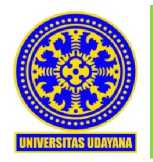
e-Journal of Linguistics
Available online at https://ojs.unud.ac.id/index.php/eol/index
Vol. 17, No. 2, July 2023, pages: 253--259
Print ISSN: 2541-5514 Online ISSN: 2442-7586
https://doi.org/10.24843/e-jl.2023.v17.i02.p14

Translation Lexicon of Traditional Plants as Rice Substitute in Nganjuk Regency, East Java
Ita Fitriana1; Dian Adiarti2; Idah Hamidah3
Universitas Jenderal Soedirman, Department of Japanese, Purwokerto, Indonesia1,3
2
Universitas Jenderal Soedirman, English Literature Study Program, Purwokerto, Indonesia2 Email: ita.fitriana@unsoed.ac.id; dian.adiarti@unsoed.ac.id; idah.hamidah@unsoed.ac.id
Article info
Abstract
Received Date: 2 Januari 2023
Accepted Date: 25 February 2023
Published Date: 31 July 2023
Keywords: traditional plant lexicons, rice substitutes, Nganjuk Regency, biodiversity, local wisdom.
Nganjuk Regency, located in East Java, is known as an agricultural production area. In the past, rice was an expensive food commodity, leading the community to seek rice substitutes. One of the alternatives was the utilization of various traditional plant lexicons such as tales, gembili, uwi, garut, ganyong, gadung, suweg, and kentang ireng. The utilization of these plant lexicons by the Nganjuk community reflects their close connection with nature. This study aims to provide a descriptive and qualitative depiction of the usage of rice substitute lexicons in the culture of Nganjuk society. Research data was collected through interviews and observations. Interviews were conducted to understand the functions and meanings of using rice substitute lexicons in Nganjuk society.The findings of this study provide a deep understanding of the diversity of traditional plant lexicons used as rice substitutes in Nganjuk Regency. It was found that mbote / kimpul, gembili, uwi, garut, ganyong, gadung, suweg, and kentang ireng are plants that have long been known and utilized by the Nganjuk community as valuable sources of carbohydrates. The utilization of these lexicons is not limited to the past but continues to the present.The community's connection with nature is reflected in their knowledge of these plant lexicons. The Nganjuk community has a profound understanding of the benefits and uses of each plant. They appreciate biodiversity and integrate this knowledge into their daily lives. However, this research also reveals a shift occurring in the younger generation. In the modern era, with abundant availability and the dominance of rice consumption, these traditional plant lexicons tend to be forgotten and less known by the current generation. This highlights the need to preserve the knowledge and traditional practices related to plant lexicons as rice substitutes. In this context, this research makes a significant contribution to enriching the understanding of cultural wealth and traditional values related to food in Nganjuk Regency. These findings can serve as a basis for developing efforts in preservation, education, and promotion of the use of traditional plant lexicons as healthy and sustainable rice substitutes.
food consumption and results in food scarcity. So, efforts to increase the variety of food consumption other than rice are increasing to reduce dependence on rice as a staple food, along with the development of time, which demands an increase in the quality of people's food consumption (Latifah and Prahardini 2020:94). Changes in food conditions that occur today not only affect technology in agriculture but also affect other fields, including the field of language. Some food names from ancient times have experienced a shift in name and even disappeared today. Therefore, research on the lexicon of traditional plants as rice substitutes in Nganjuk Regency is an interesting topic to explore further.
One example is tiwul. This food has been popular since ancient times. It is not known exactly when tiwul began to be made, but it became a staple food for most Javanese people during the Japanese colonial period (Jesica et al. 2017:1). Although in the past it was very popular and spread to several places on the island of Java, at this time the term tiwul is no longer recognized by the current generation.
The lexicon change occurred due to the scarcity of rice as a staple food in ancient times, so other alternatives to rice were sought. Today, rice is easily found everywhere, causing the shift to tiwul as a substitute for rice. From the explanation above, this research uses ecolinguistic theory as a data analysis tool. According to Umiyati (2023:1066), ecolinguistics seeks to explore linguistic phenomena found in the relationship between languages, between people, and between humans and nature from the perspective of ecological philosophy. Ecolinguistics is a concept that links the study of linguistics with ecology (Nahak and Simpen 2020:46). In the context of linguistics, ecology has a significant role. The existence of ecology in the field of linguistics refers to the sustainability of the language itself.
The definition of ecolinguistics was first coined by Haugen (1972:325), namely the study of the interaction between language and its environment. This definition considers that the "language environment" is equal to the interaction environment obtained in an ecosystem. Therefore, this branch of linguistics can also be called ecosystem linguistics (do Couto 2018:149). Ecolinguistic studies are needed to examine the reciprocal relationship between nature or the surrounding environment and language. In a society, any speech must master, use, and recognize words and discourse related to its environment, either the natural environment or the social environment.
A lexicon is a collection of morphemes or linguistic units used in a particular language. Specifically, a lexicon refers to an inventory or list of morphemes present in a language, including root words, affixes, idioms, phrases, and other forms. In a lexicon, morphemes are organized by linguistic categories or groupings of similar morphemes. The lexicon in local languages is an inseparable part of Indonesia's cultural heritage that continues to live and develop today, and its preservation efforts are very important so that it is not eroded by rapid progress through electronic media (Umar 2020:71). Lexicons in local languages are used by local communities as a means of daily communication, so they are considered appropriate and accurate by them (Nirmalasari et al. 2019:233).
Based on the perspective of cognitive anthropology (Stukan 2018:27), a set of lexicons is a sign object and an important activity event in the environment. The dynamics of lexicon existence are influenced by changes in the environment in which a language is used. This is evidenced by the use of local language lexicons by farming communities in Gunung Kidul district, namely gaplek, tiwul, and gatot, but these lexicons are not found in Nganjuk district. Tiwul, gaplek, and gatot are traditional foods made from cassava (Ambarsari, Endrasari, and Anomsari 2022:1).
So far, people have consumed many types of tubers that are commonly found, such as cassava, sweet potatoes, and potatoes. In addition, there are still various other types of tubers that have potential but have not been widely explored, such as mbote/kimpul, gembili, uwi, arrowroot, ganyong, gadung, suweg, and kentang ireng.
Changes in people's consumption patterns from rice to wheat flour used in instant noodles and bread show that public interest in food ingredients derived from tubers is still limited. This limited consumption of tubers may be due to the perception that the majority of the population who consume these foods are considered plebeian, not prestigious, obsolete, poor people's food, and lack quality (Hanafie 2010:2).
This study aims to explain in detail the traditional plant lexicon that has been used by people in Nganjuk Regency as a substitute for rice. In the analysis of ecolinguistic theory, it
looks at how language reflects human interaction with their natural surroundings and how the selection of traditional plants as rice substitutes contributes to environmental sustainability and the welfare of local communities.
By providing comprehensive information on the lexicon of traditional plants as rice substitutes in Nganjuk Regency, it is hoped that it can increase people's awareness of the potential of local natural resources and their cultural heritage in developing healthy and diverse food choices. In addition, this research is also expected to be a useful reference source for researchers, practitioners, and policymakers in the development of sustainable food policies and cultural preservation in Nganjuk District.
This study uses a qualitative descriptive approach. In this case, it provides a thorough explanation of language phenomena related to meaning and environment, especially about the lexicon of rice substitutes used by residents of Nganjuk Regency in their daily lives. The data collected in this study were obtained through three stages: first, data collection using the techniques of the fishbowl, recording, and note-taking technique; second, data analysis; and finally, the presentation of the analysis results. In the data provision stage, two methods were used: the listening method and the speaking method. Researchers conducted direct interviews with informants or main data sources.
This is in line with (Mahsun 2012:93), who states that the method of providing data with the chap method because the data collection method consists of interviews between researchers and informants. In addition, for the data analysis part, the equivalent method and the method of apportioning. In this study, the referential exemplar method is used, which is the basic technique of the determining element sorting technique. Furthermore, the distributional method is based on the direct elemental division technique. The dissemination of the results of data analysis is through an informal approach.
Interviews with locals in Nganjuk Regency who have knowledge and experience with traditional plants as rice substitutes were used to obtain data for this study. The information for this study was gathered through interviews with native speakers of the Nganjuk dialect of Javanese.
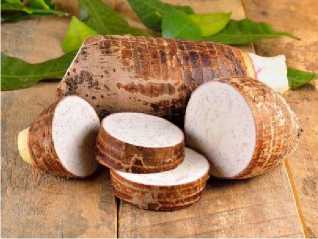
Figure 1 – Mbote / kimpul 'taro'
In data F 1 is mbote / kimpul which was widely used as a staple food to replace rice during the Japanese colonial period. Mbote / kimpul is processed simply by boiling then immediately served for breakfast, lunch or dinner. However, nowadays it is rare to find taro as a staple food. The processing of taro by the community is usually only steamed, made into chips, or fried. Apart from mbote or kimpul, there are other types of taros that can be used as food, namely bentoel, bogor taro, and padang taro. Many processed foods made from taro are currently found and become modern food preparations, such as cakes, breads, drinks, biscuits, and so on. Even processed taro or internationally known as taro was introduced by Taiwanese culinary which processed taro into bubble tea, pudding, fried foods, and taro qball.
-
3.2. Data F 2
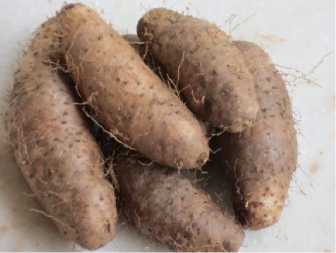
Figure 2 – Gembili
Data F 2 is gembili. During the Japanese occupation in Indonesia, gembili was used as a staple food. Gembili grows well in people's yards. Gembili is oval in shape but there is also a branched shape. The surface of the tuber is smooth, the color of the tuber skin is beige to light brown, the color of the cortex is greenish yellow and the color of the tuber flesh is clear white to cloudy white. The gembili bulbs are about 4 cm in diameter, 4 cm to 10 cm long with a round or oval shape. The skin of the bulb is about 0.04 cm thick. The skin of the bulb is easy to peel because it is quite thin. The weight of the tuber is about 100 - 200 grams.
Gembili is eaten boiled or steamed. However, not many people, especially from the current generation, are familiar with gembili. Although it is still grown in the countryside, gembili is almost never found in markets, including traditional markets. Gembili has a unique taste, which is savory and has a slight earthy smell that makes its aroma distinctive. In addition to being a food ingredient, raw gembili can be used as a remedy for bruises or swelling by grating and compressing it to the bruised place.
-
3.3. Data F 3
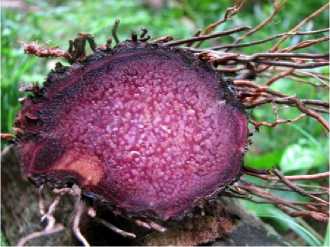
Figure 3 – Uwi
Data F 3 is uwi. In the past, uwi was one of the alternative foods, a helper in times of famine. When the drought hit, rice could not be harvested, so people would consume tubers such as uwi. Unfortunately, uwi is still less popular than other bulbous plants such as potatoes, cassava and sweet potatoes. The cultivation of uwi is not yet on a large scale, often considered a wild plant that grows creeping in the yard. In fact, uwi is relatively easy to plant and harvest during the dry season. In the past, uwi was used during the dry season and in the rainy season people would plant it again."
-
3.4. Data F 4
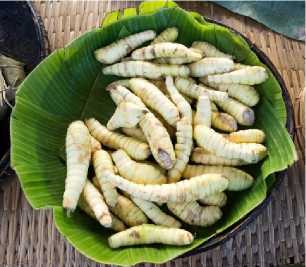
Figure 4 – Garut ‘arrowroot’
Data F 4 is garut or in English is called arrowroot which was widely used as a staple food to replace rice during the Japanese colonization. Just like taro, arrowroot is processed simply by boiling then immediately served for breakfast, lunch or dinner. However, nowadays people rarely consume arrowroot as a staple food. As a result, it is rare to find arrowroot sellers. So, people no longer plant garut for sale. This does not rule out the possibility that in the future the lexicon garut will no longer be recognized by future generations.
-
3.5. Data F 5

Figure 5 - Ganyong
Data F 5 is ganyong which was widely used as a staple food to replace rice during the Japanese colonization. Ganyong is currently a foreign name for children of the internet generation. This plant, whose name seems hokey, has many good benefits for consumption as a substitute for rice.
Ganyong is processed simply by boiling and then immediately served for breakfast, lunch or dinner. However, nowadays it is rare to find ganyong as a staple food. This is because the national availability of rice is quite high, in contrast to the conditions of the past, rice is still rare and not everyone can afford rice even though rice is quite desirable than ganyong, so the lexicon ganyong could be unknown in the future.
-
3.6. Data F 6
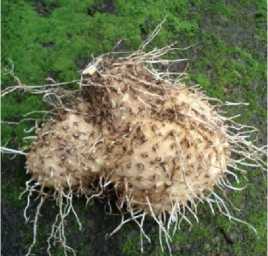
Figure 6 – Gadung
Data F 6 is gadung, a type of tuber in the forest. In the past, gadung was the main food for people in Nganjuk district. However, nowadays people's interest in consuming gadung is starting to disappear because it has been replaced by rice. In addition, processing gadung requires its own skills. If not processed properly, it can cause poisoning such as discomfort in the throat, dizziness, vomiting blood, choking, drowsiness, fatigue and even death. In the future, it is possible that gadung will remain just a name. The lexicon of gadung may become extinct as it is not recognized by future generations.
-
3.7. Data F 7
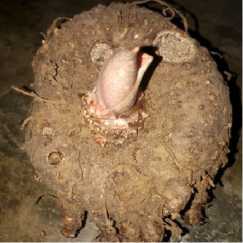
Figure 7 – Suweg
Data F 7 is suweg which is widely used as a staple food to replace rice. But nowadays many people no longer want to use suweg. Rice is more desirable than suweg so that the rice substitute staple food is only a name, this is because suweg is no longer a staple food, so the existence of suweg lexicon is also starting to be threatened.
-
3.8. Data F 8
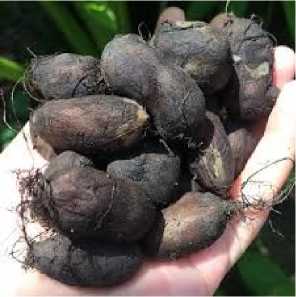
Figure 8 - Kentang ireng 'black potato'
Data F 8 is a kentang ireng ‘black potato’. Kentang ireng are currently rarely found in traditional markets in Nganjuk district. Not surprisingly, not many people know that today's generation knows him. Kentang ireng may sound strange and unfamiliar. Even though kentang ireng were once one of the staple food sources in Nganjuk district. However, currently one of these foodstuffs is forgotten. Kentang ireng are less desirable than rice. So that the staple food that replaces rice, in the future, will remain just a name and have an impact on the existence of the lexicon of kentang ireng.
This study is based on the proposal of Wuryantoro and Arifin's (2017) previous study on the same topic but with different objects and methods entitled "Eksplorasi dan Identifikasi Tanaman Umbi-Umbian (Ganyong, Garut, Ubi Kayu, Talas, dan Suweg) di Wilayah Lahan Kering Kabupaten Madiun". In this study, the types and meanings of language styles are proposed based on the perspective of the study of the research object. The traditional food found in the district of Nganjuk is one of the snacks that have been forgotten by the younger generation today. Therefore, considering that the lexicon of traditional food will be lost if it is not preserved, it is necessary to document the language through lexicon.
From the data analysis, it can be concluded that sweet potatoes such as mbote / kimpul, gembili, uwi, garut, ganyong, gadung, suweg, and kentang ireng are rarely recognized by the younger generation. There is even an assumption that eating these sweet potatoes is "old-fashioned food" which is no longer in accordance with their prestige as young people. Let alone as a snack or snack, the younger generation in Nganjuk Regency tends to choose bread with its many variants, biscuits, chocolate, and so on compared to eating mbote / kimpul, gembili, uwi, garut, ganyong, gadung, suweg, and kentang ireng. This condition is very concerning for the existence of the lexicon of mbote / kimpul, gembili, uwi, garut, ganyong, gadung, suweg, and kentang ireng because it can result in the future that the younger generation will be unfamiliar with traditional food.
The highest appreciation is dedicated to University of Jenderal Soedirman, Indonesia for the research funding and to all parties who support the research and its publication.
Ambarsari, Indrie, Retno Endrasari, and Selvia Dewi Anomsari. 2022. “Nutritional and Sensory Characteristics of Tiwul Made from Different Fortified Tuber Flours.” E3S Web of Conferences 361:04008. doi: 10.1051/e3sconf/202236104008.
do Couto, Hildo Honório. 2018. “Ecosystemic Linguistics.” Pp. 149–61 in The Routledge Handbook of Ecolinguistics, edited by A. F. Fill and H. Penz. New York and London: Routledge.
Hanafie, Rita. 2010. “Peran Pangan Pokok Lokal Tradisional Dalam Diversifikasi Konsumsi Pangan.” Jurnal Sosial Ekonomi Pertanian 4(2).
Haugen, Einar Ingvald. 1972. The Ecology of Language. Stanford: Stanford University Press.
Jesica, Claudia, Estherina Cansa, Jennica Fidelia, Jeremiah Irwan, and Yosua Wira Adi Nugroho. 2017. “Gaplek, Tiwul and Gatot as Staple Food in Javanese Barren Area.” International Journal of History and Research 7(4):1–6. doi: 10.24247/ijhrdec20171.
Latifah, Evy, and PER Prahardini. 2020. “Identifikasi Dan Deskripsi Tanaman Umbi-Umbian Pengganti Karbohidrat Di Kabupaten Trenggalek.” Agrosains : Jurnal Penelitian Agronomi 22(2):94. doi: 10.20961/agsjpa.v22i2.43787.
Mahsun. 2012. Metode Penelitian Bahasa. Depok: Kharisma Putra Utama Offset.
Nahak, Maria Magdalena Namok, and I. Wayan Simpen. 2020. “The Ritual of Ecolexicon in the Text of Batar in Tetun Fehan Malaka,Timor, East Nusa Tenggara Province: Ecolinguistic View.” E-Journal of Linguistics 14(1):44. doi: 10.24843/e-jl.2020.v14.i01.p05.
Nirmalasari, Nirmalasari, Aron Meko Mbete, I. Wayan Simpen, and Anak Agung Putu Putra. 2019. “Falia‘s Ke-Kaghati-an in Muna Speech Community From the Ecolinguistic Perspective.” E-Journal of Linguistics 13(2):233. doi: 10.24843/e-JL.2019.v13.i02.p04.
Stukan, Diana. 2018. “Sociopragmatic Failure: Struggling with Cross-Cultural Differences in Communication.” Open Journal for Anthropological Studies 2(1):27–36. doi: 10.32591/coas.ojas.0201.03027s.
Umar, Umar. 2020. “The Meaning Difference of Lexicon ‘Sakit’ in Bimanese: A Semantic Perspective.” E-Journal of Linguistics 14(1):71. doi: 10.24843/e-jl.2020.v14.i01.p08.
Umiyati, Mirsa. 2023. “Lexicon Distinctiveness Used in ‘Awig-Awig’ Text in Tenganan Village Bali: An Ecolinguistics Study.” Theory and Practice in Language Studies 13(4):1065–75. doi: 10.17507/tpls.1304.29.
Wuryantoro, and Mochamad Nur Arifin. 2017. “Explorasi Dan Identifikasi Tanaman Umbi-Umbian (Ganyong, Garut, Ubi Kayu, Ubi Jalar, Talas Dan Suweg) Di Wilayah Lahan Kering Kabupaten Madiun.” AGRI-TEK: Jurnal Ilmu Pertanian, Kehutanan Dan Agroteknologi 18(2):72–79.
Biography of Authors


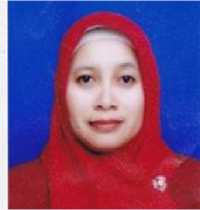
Ita Fitriana received her undergraduate degree in 2010 and her master's degree in 2012, both from Universitas Gadjah Mada. In 2022, she obtained her doctoral degree from Universitas Udayana. In 2016-2017, she participated in the "Long Term Japanese Teacher Training" program sponsored by the Japanese government in Japan. Since 2014, Ita Fitriana has been working as a lecturer in the Japanese Department at the Faculty of Humanities, Universitas Jenderal Soedirman, located in Purwokerto, Indonesia.
Dian Adiarti completed her bachelor's degree in 2001 at the State University of Malang in English Education and her master's degree in 2007 in Literature. She is currently a lecturer in the English Literature study program at the Faculty of Humanities, Universitas Jenderal Soedirman since 2008.
Idah Hamidah has been a lecturer at the Faculty of Humanities, Universitas Jenderal Soedirman since 2005. She was born in Sumedang Regency, West Java. She completed her bachelor's degree at Padjadjaran University in Linguistics in 1999 and her master's degree at the University of Indonesia in Linguistics in 2009.
Discussion and feedback